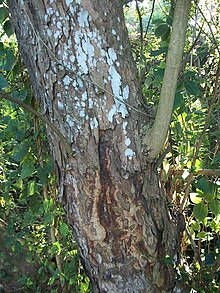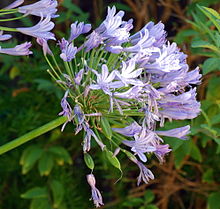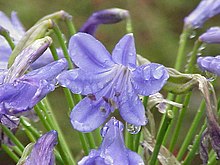Muti
| This article is part ofa serieson |
| Alternative medicine |
|---|
 |
Muthiis atraditional medicinepractice inSouthern Africaas far north asLake Tanganyika.
Name
[edit]
InSouth African English,the wordmutiis derived from theZulu/Xhosa/Northern Ndebeleumuthi,meaning 'tree', whose root is-thi.InSouthern Africa,mutiand othercognatesofumuthiare in widespread use in most indigenous African languages as well as in South African English andAfrikaans,which sometimes usemutias a slang word for medicine in general.[1]
This noun is of theumu/imiclass so the singular ('tree') isumuthiand the plural ('trees') isimithi.Since the pronunciation of the initial vowel of this class is unstressed, the singular is sometimes pronouncedmuthi.The word is rendered asmutiby the historical effects of the Britishcolonialspelling.
In colloquial English and Afrikaans the wordmutiis often used to refer to medicines in general or medicines that have a 'miraculous' effect, e.g.
- "Die dokter het 'muti' op die seerplek gesmeer en die volgende dag was dit heeltemal gesond."(The doctor rubbedmution the wound and the next day it was completely healed.)
- "My dokter het vir my 'muti' verskaf vir my seer keel."(" My doctor gave me somemutifor my sore throat. ")
Traditional medicine
[edit]Africantraditional medicinemakes use of various natural products, many derived from trees and other plants. Botanical medicine prescribed by aninyangaor herbal healer is generally known as "muthi", but the term can apply to other traditional medical formulations, including those that are zoological or mineral in composition.
Vulturebrains are used for prophecy in muthi.[2]
Use of Isicakathi in the Eastern Cape
[edit]
Isicakathiis a term that is used byXhosa peoplewhen referring to plants with supposed pharmacological and therapeutic properties that are used as medicine for various ailments.[3]
The people in the Eastern Cape of South Africa still strongly rely on traditional medicine and believe in its potency as an alternative to western medicine.[3]There are various herbs that fall underisicakathi,used forpre-natalandpost-natalmedicine (although they can also be used for non-pregnancy related health issues).[3]The plants that fall under theisicakathicategory differ according to the districts in the Eastern Cape, hence it is a general term used when referring to traditional medicine.[3]There are eleven species of plants that fall underisicakathi,namelyCommelina africana,Agapanthus praecox,Chlorophytum comosum,Ledebouria ovatifolia,Ranunculus multifidus,Thunbergia atriplicifolia,Kohautia amatymbica,Plantago major,Gazania linearis,Helichrysum pedunculatumandSenecio coronatus.[3]The use of these plants differs according to the various areas/ districts of the Eastern Cape.[3]Commelina africanais used for menstrual problems, pelvic pains and bladder related issues.[4]Agapanthusis found in pre-natal and post-natal medicine, which is used by pregnant women.[3]Chlorophytum comosumis used as a protective charm against evil spirits for both mother and child.[5]Ledebouria ovatifoliais used for medicinal purposes, including pregnancy, diarrhoea, influenza, backaches, skin irritations and wounds.[6]Ranunculus multifidusis used for epileptic fits in adults, lung problems and used as an emetic.[3]Kohautia amatymbicais also used as an emetic.[7]Plantago majoris used for wounds, inflammations, and eye irritations.[8]Gazania linearisis applied on small cuts made on the body close to the joints to protect someone from evil spirits.[3]Helichrysum pedunculatumis used as a dressing after circumcision and to prevent the wound from getting septic.[3]Senecio coronatusis used to get rid of pubic lice.[3]Generally,isicakathior plants that are regarded to fall underisicakathiare mostly used by pregnant women and children.[3]Thus, it is also used as a protective measure against sorcery during pregnancy.[9]
Isicakathi for pre-natal and post-natal care
[edit]Agapanthus praecoxis one of the plants that falls underisicakathiused during pregnancy. It is taken orally from the six month of pregnancy until delivery. The plant is put in a container full of water and half a cup of that water is taken orally, twice a day, in the morning and in the evening.[3]It is believed that the plant’s growth determines the health of the unborn baby. The wilting of the plant is regarded as a symbol with regards to the baby's health, usually associated with death. Isicakathiis widely used to induce easychildbirth.[3]It ensures that excess water is drained, reduces vaginal discharge and placental size.[10]The plants treathigh blood pressurein both antenatal and postnatal care for women, whilst also preventing constipation.[11]
Rhoicissus tidentatais used to induce labour; its root can be used to prepare anenema.Erythrina lysistemonis used to induce labour pains during the childbirth process via pieces of the trunk's bark bound together and infused for the woman to drink. The crushed bulb ofGunnera perpensais used to reduce swelling of the feet by infusing with boiling water and ingesting.[12]
The use of Isicakathi on the baby
[edit]Salvia scabra,mixed with the mother’s milk, is given as medicine to infants. The mixture is given to the baby to ingest every day for two months.[3] Isicakathiis generally used to induce growth and prevent diseases. It is also used as an alternative to the mother’s milk and to counteract the milk’s sourness.[3]The use ofAgapanthus praecoxensures that the baby is strong, whilst preventing bowel problems and crusts on its head.[13]
An ointment is used to hasten the parturition of the baby and placenta using the leaves ofScutia mytina.Erythrina humeanais used to heal the umbilical cord of the baby by burning the bark and using the powder to apply on the baby.[12]


Muti killings
[edit]Occasions of murder with mutilation associated with some traditional medicine practices in South Africa have been termedmuti killings.These are nothuman sacrificesdirectly, but rather involve the murder of someone in order to harvest body parts for incorporation into traditional medicines and rituals.
In February 2010, Deputy Provincial Commissioner William Mpembe of the South African Police Service (SAPS) in North West Province said that "muti murders, particularly those involving young children, seem to be on the rise in the Tshwane areas including Soshanguve, Garankuwa and Rietgat".[14]That same month, African traditional healers and the Gauteng government convened at a seminar in Pretoria, South Africa to root out the "evil practice of mutilating human bodies for purposes of muti making."[15]
See also
[edit]References
[edit]- ^"Traditional African Healing".African Code. Archived fromthe originalon 24 August 2012.Retrieved18 September2012.
- ^Elizabeth Royte (January 2016)."Vultures Are Revolting: Here's Why We Need to Save Them".National Geographic.Archived fromthe originalon December 4, 2016.Retrieved25 November2018.
- ^abcdefghijklmnopBolofo, R. N; Johnson, C. T (1988)."The identification of 'Isicakathi' and its medicinal use in Transkei".Bothalia.18(1): 125–30.doi:10.4102/abc.v18i1.995.
- ^"SANBI.Commelina Africana".PlantZAfrica.com.
- ^Hutchings, A., Scott, A.H., Lewis, G. & Cunningham, A.B. 1996. Zulu medicinal plants. An inventory. University of Natal Press, Pietermaritzburg.[page needed]
- ^"SANBI.Ledebouria".PlantZAfrica.com.
- ^"Kohautia amatymbicaEckl ".Prota4u.
- ^Gaby H et al.MedicinalPlants,Volume1.
- ^Abrahams, N; Jewkes, R; Mvo, Z (2002). "Indigenous healing practices and self-medication amongst pregnant women in Cape Town, South Africa".African Journal of Reproductive Health.6(2): 79–86.doi:10.2307/3583133.JSTOR3583133.PMID12476719.
- ^Varga, C.A; Veale, D.J.H (1997). "Isihlambezo: Utilization patterns and potential health effects of pregnancy-related traditional herbal medicine".Social Science & Medicine.44(7): 911–924.doi:10.1016/S0277-9536(96)00104-9.PMID9089914.
- ^Reis, Aryane C; Franco, ANA Luiza; Campos, Victória R; Souza, Flávia R; Zorzatto, Cristiane; Viccini, Lyderson F; Sousa, Saulo M (2016)."RDNA mapping, heterochromatin characterization and AT/GC content of Agapanthus africanus (L.) Hoffmanns (Agapanthaceae)".Anais da Academia Brasileira de Ciências.88(3 suppl): 1727–1734.doi:10.1590/0001-3765201620150514.PMID27556330.
- ^abDlisani, P.B; Bhat, R.B (2008)."Traditional Health Practices in Transkei with Special Emphasis on Maternal and Child Health".Pharmaceutical Biology.37:32–36.doi:10.1076/phbi.37.1.32.6316.
- ^Sharaibi, Olubunmi Josephine; Afolayan, Anthony Jide (2017)."Micromorphological Characterization of the Leaf and Rhizome of Agapanthus praecox subsp. Praecox Willd. (Amaryllidaceae)".Journal of Botany.2017:1–10.doi:10.1155/2017/3075638.
- ^"Cash for organs is no joke".sowetanlive.co.za.Sowetan Live and SAPA. 25 February 2011.Retrieved3 July2012.
- ^SAPA (19 February 2010)."Muti killings to be tackled".news24.com.News24. Archived fromthe originalon 18 June 2011.Retrieved3 July2012.

